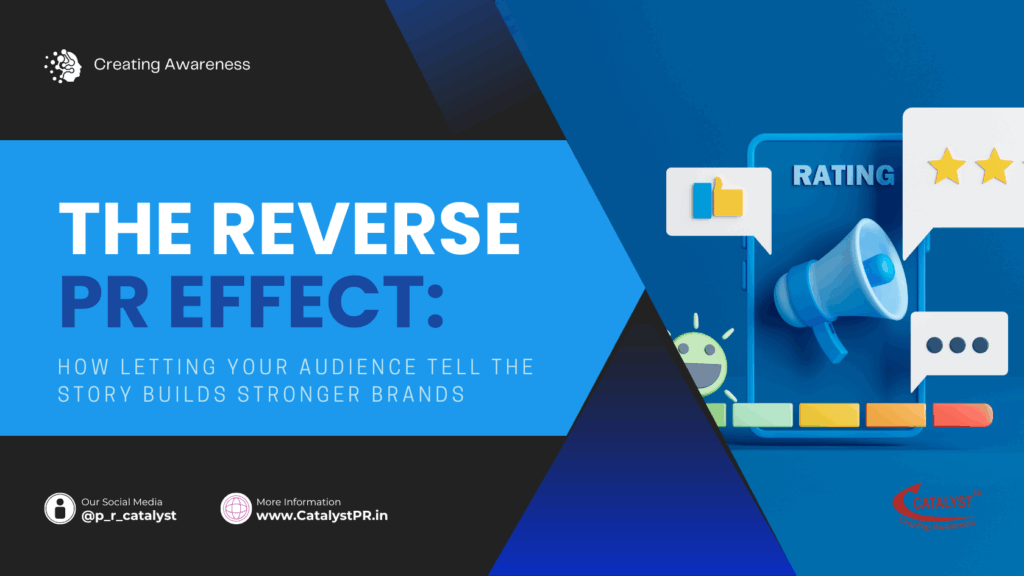Introduction
For decades, public relations was built on control — control of the message, control of the tone, and control of where and how that message reached the world. Brands hired agencies to shape the story, ensure media alignment, and protect their reputations from misinterpretation.
Yet in 2025, the landscape tells a different tale. Today’s audiences are savvier, more connected, and far more skeptical of brand-originated messages. They scroll past ads without a glance, treat corporate statements with suspicion, and look for validation from people they trust.
This shift has paved the way for a powerful new approach to PR — Reverse PR — where your audience, not your marketing team, becomes the voice of your brand.
What is Reverse PR?
Reverse PR turns the traditional model on its head. Instead of pushing out highly polished brand messages from the top down, it focuses on pulling authentic stories from the ground up — from customers, employees, communities, and even industry peers.
It’s about creating an environment where people want to talk about you — not because they are paid, but because they genuinely believe in the story.
In Reverse PR:
- The brand becomes the stage, not the actor.
- The PR team facilitates and amplifies stories, rather than scripting them entirely.
- The narrative evolves organically through shared experiences, reviews, content, and conversations.
Why Reverse PR Works in 2025
The internet’s democratization of media means that anyone can be a journalist, critic, or influencer. In this noisy marketplace, authenticity is the loudest voice. Here’s why Reverse PR resonates:
1. Trust is Bottom-Up, Not Top-Down
Edelman’s Trust Barometer consistently shows that “a person like me” is more trusted than CEOs, celebrities, or corporate spokespeople. Reverse PR taps into that trust by letting real people be the storytellers.
2. Content Becomes Self-Sustaining
With traditional PR, you need constant investment to keep visibility alive — press releases, campaigns, paid media. With Reverse PR, each authentic story sparks another, creating a chain reaction of organic visibility that requires far less budget over time.
3. Crisis Control Through Transparency
In a crisis, a brand that actively engages with its community can weather the storm more effectively. Reverse PR builds a reservoir of goodwill so when something goes wrong, your audience speaks for you, not against you.
4. It Humanizes the Brand
People don’t want to talk to faceless corporations — they want human connection. Reverse PR bridges the gap by making the audience an extension of the brand voice.
Real-World Examples of Reverse PR
- GoPro’s Entire Marketing Model
Instead of relying on big ad spends, GoPro built its brand on user-generated videos. Every extreme sports clip became free advertising and authentic proof of the product’s capability.
- Glossier’s Customer-Led Product Launches
The beauty brand turned its Instagram followers into focus groups, letting them vote on product features and shades. When the products launched, the customers became the most vocal promoters.
- Tesla owners as Brand Ambassadors
Without traditional ads, Tesla’s story is told by its passionate owners, who share experiences online, organize meetups, and answer questions for curious buyers.
How to Implement Reverse PR
Here’s how your brand can harness this approach effectively:
1. Create Safe Story Spaces
Give customers and employees platforms where they can share their stories — without fear of corporate censorship. These could include:
- A dedicated hashtag campaign (#MyBrandStory)
- A community-driven forum or LinkedIn group
- A regular “Customer Spotlight” feature on your blog or social media
2. Empower Your Advocates
Identify your biggest supporters — customers, industry peers, micro-influencers — and give them tools to tell their story better:
- Early access to products
- Exclusive behind-the-scenes content
- Invitations to private events or webinars
3. Curate, Don’t Control
Your PR team should shift from creating every piece of content to curating the best audience-generated material. Feature testimonials, repost user videos, or write case studies based on customer success stories.
4. Engage Like a Human
Drop the corporate jargon. Reply to comments with humor, empathy, and real personality. People are far more likely to talk about a brand that talks with them, not at them.
The Risks — and How to Manage Them
Yes, giving up control comes with risks:
- Negative Stories: Not all user-generated content will be glowing praise. But responding with transparency can turn critics into loyalists.
- Off-Brand Messaging: Set some loose guardrails for tone and messaging, but avoid over-policing — or you lose authenticity.
- Scalability: Managing large volumes of user content takes resources. Consider AI-assisted moderation tools to handle volume without losing personal touch.
The Future of PR is Collaborative
In the next five years, the brands people trust most will be the ones that co-create their story with their audience. The winners won’t be those shouting the loudest, but those with the most eager storytellers.
Reverse PR isn’t about losing control. It’s about shifting from being the hero of the story to the guide that helps others tell it.
When your audience tells your story — and tells it well — you’re no longer just selling a product. You’re building a movement.
Call to Action:
Ready to turn your customers into your most powerful PR team? Start by listening more than you talk — and by amplifying the voices that matter most.


